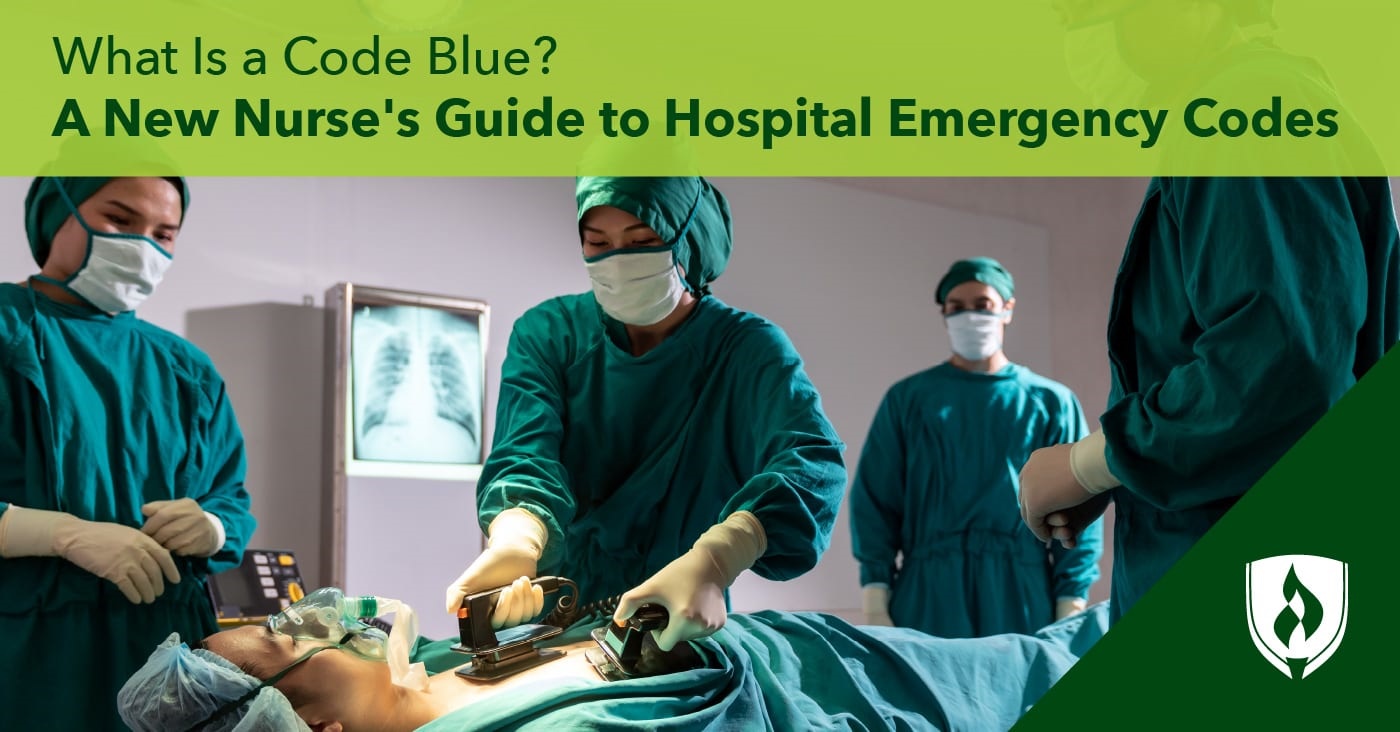
Chances are you’ve seen a medical drama where “code blue” comes over the PA system. Nurses and doctors rush to save a patient’s life, and as they start CPR, someone calls “clear” to prepare to defibrillate. These shows obviously sensationalize the situation, but real-life code blues are still high-stress, high-stakes emergencies.
Thankfully for the rest of us, healthcare providers are trained to navigate hospital emergency codes with a cool head. Procedures and systems keep the chaos to a minimum so everybody can focus on their role in saving the patient’s life.
Hospitals use these color codes to quickly and clearly label emergencies while preventing hospital visitors from panicking. If you’ve ever wondered what a code blue actually is and how these hospital codes work, you’re in the right place.
What is a code blue?
The color code you’ve probably heard before is code blue. When this is called, there’s a patient who needs immediate emergency medical attention. It signals that the code blue team should drop everything and rush to the announced room number.
Any healthcare provider who finds a patient who isn’t breathing, has no pulse or is unresponsive will immediately call a code blue. They will also start trying to resuscitate the patient while they wait for more help to arrive.
Emergency color codes can differ across regions or hospitals, as some facilities specifically use code blue for cardiac arrest, and in some states, the code applies only to adults. However, wherever you are, code blue alerts the hospital that a patient needs nurses and doctors as soon as possible.
What are the roles in a code blue?
Because of the urgency and pressure of code blues, these emergencies have a system with defined roles. This way, everybody knows what they need to do, and no time is wasted on logistics. Indeed, having a system can help nurses and doctors automatically take action rather than freezing in the stressful situation.
“Your role in a code blue depends on several factors such as your experience, your knowledge, your skills and your timing,” says Nicholas McGowan, MSN, RN, CCRN, founder of Critical Care Academy. “For example, if you arrive at a code and there’s a room full of nurses already, there’s probably no need for you to jump in.” In this case, McGowan recommends finding another way to help—like by delivering supplies or supporting the patient’s family if they are nearby.
In total, there are six distinct roles in a code blue, starting with the person who called in the code. As other nurses and doctors enter the room, they declare their role to avoid confusion.
1. First responder (CPR)
The first person to respond to the code blue starts chest compressions at a rate of 100 beats per minute. The goal is to get oxygen circulating through the patient. When others arrive, they can place a backboard beneath the patient, but the first responder won’t wait to begin compressions. At two-minute intervals, the healthcare professional giving CPR alternates with another professional to maintain proper, steady compressions.
2. Airway manager
The next responder attends to the patient’s airway. While a patient in cardiac arrest may be able to survive for several minutes with only air from the chest compressions, they are still in critical need of oxygen. The airway manager operates a bag-mask ventilation device, setting the correct oxygen level and timing ventilations with chest compressions.
3. Defibrillator operator
Now that the patient has a flow of oxygen, the next concern is their heart rate. Clear communication is important when using the defibrillator to ensure the right amount of energy is used and to prevent anybody else from getting shocked. This is why in TV shows (and real life), they shout “clear” to tell everybody to not touch the patient or the patient’s bed. Right after defibrillation, the chest compressions start again.
4. Crash cart operator
While the defibrillator operator handles the defibrillator, the crash cart operator handles the rest of the crash cart. They stand on the side of the patient with the IV and need room to open all the drawers on the cart. They also need to know where everything is located within the cart for quick access. If and when the patient needs medication, the crash cart operator is responsible for administering it—this is why they stand by the IV.
5. Leader
While the first four roles focus on specific resuscitation tasks, the leader—typically a physician or advanced practice provider—pays attention to every aspect of the situation. They track the patient’s heart rate, monitor the resuscitation and communicate with all the other roles.
An important part of any code blue is clear communication. The leader uses a closed-loop system where they give an instruction, the other team member repeats the order, performs the action, then says they have performed the action.
With so many people working in what is often a cramped room, the leader also ensures everybody has space to perform their job. This may mean adjusting furniture or relocating any other patients in the room. And if anybody else shows up, the leader tells them what to do, whether that be helping out or waiting outside.
6. Documenter
This final role also helps oversee the whole situation. As the name implies, the documenter is responsible for documenting the code blue, noting information like the patient’s heart rate before any defibrillations.
Additionally, the documenter supports the other roles. They tell the compressors to switch every two minutes, and they tell the other team members information about the last medication the patient received.
Another twist to this role is that different hospitals will have different documentation methods based on their electronic systems. The documenter needs to understand this system and label all information with the date, time and the patient’s identifying information.
Advice for nurses in a code blue
All this may seem overwhelming, but McGowan offers encouragement to future and new nurses. His advice is to rely on your training as a nurse, survey the room and maintain situational awareness.
“I have never seen a perfect code blue,” he says. “Each code involves a different patient, with different complications and different staff, in a different environment. There is always a level of chaos involved with codes, so it is imperative to maintain a calm and confident demeanor regardless of what is going on in your head.”
In these stressful situations, McGowan also says, “If you find yourself directly involved in the code but aren’t confident in your skills, jump on a round of chest compressions. By doing that, you are in the middle of the ‘action,’ and you can better assess everything that’s going on.”
His final and most important piece of advice is to confirm the code before you do anything. When you enter the room, make sure there is a code blue. If, for whatever reason, there is not a code blue in that room, then you could seriously injure the patient by starting compressions, ventilations or any action.
What are the other hospital emergency codes?
Code blue is only one emergency code in hospitals. Nurses need to be familiar with several other code statuses to keep patients and everyone in the hospital safe. Even though there’s not a standard nationwide code system, many hospitals do use the same common codes and have similar response plans.
1. Code red
In a code red, somebody has seen fire or smoke. In this situation, hospital personnel first move people away from the fire to safety and attempt to extinguish or contain the fire. The hospital also calls 911 in case firefighters will be needed.
2. Code gray and silver
Code gray and code silver both mean there’s an emergency requiring a security response. Code gray means there’s a combative person in the hospital or another circumstance needing security, and code silver means there’s an armed intruder or hostage situation. When these codes are called, the hospital will contact law enforcement and lock down the facility to protect patients.
3. Code pink
Similar to the Amber alerts used by the general public, code pink refers to an infant or child abduction. In these scenarios (https://home.llu.edu/sites/home.llu.edu/files/docs/lluh-11-4-code-pink-infant-abduction.pdf), hospitals will carefully search the building and screen people attempting to leave the facility, in case the abductor and child haven’t left yet. Additionally, they will contact the police to help find the child.
4. Code orange
Code orange is a hazmat emergency. This could either be an internal incident or somebody coming to the hospital who has been contaminated with hazardous materials. The hospital will prepare to contain the situation and treat anybody who was exposed. And depending on the circumstances, the hospital may evacuate.
5. Code black
Finally, code black is a bomb or bomb threat. Thankfully, an actual bomb in a hospital is a rare event. But when there is a bomb threat, the hospital will call law enforcement, conduct a search for anything suspicious and may evacuate.
Is a career saving lives for you?
While these hospital emergency codes are intense situations, healthcare professionals have training to rely on through each new event. And at the end of the day, they can rest well knowing they save lives.
If you’re ready to enter this fulfilling field, take the next step toward becoming a nurse and learn more about nursing programs. Or if you’re unsure how to become a nurse, find out more about the different types of nursing credentials with our article “A Beginner’s Guide to Understanding the Levels of Nursing Credentials.”
Related Articles:




